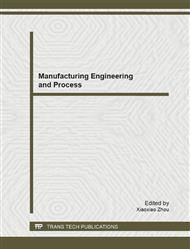[1]
Madalina Calamaz, Dominique Coupard, Franck Girot, A new material model for 2D numerical simulation of serrated chip formation when machining titanium alloy Ti–6Al–4V, International Journal of Machine Tools & Manufacture 48 (2008) 275–288.
DOI: 10.1016/j.ijmachtools.2007.10.014
Google Scholar
[2]
M.C. Shaw, S.O. Dirke, P.A. Smith, N.H. Cook, E.G. Loewen, C.T. Yang, Machining Titanium, Massachusetts Institute of Technology, (1954).
Google Scholar
[3]
R. Komanduri, B.F. Turkovich, New observations on the mechanism of chip formation when machining titanium alloys, Wear 69 (1981) 179–188.
DOI: 10.1016/0043-1648(81)90242-8
Google Scholar
[4]
A. Vyas, M.C. Shaw, Mechanics of saw-tooth chip formation in metal cutting, Journal of Manufacturing Science and Engineering 121 (1999) 163–172.
DOI: 10.1115/1.2831200
Google Scholar
[5]
J. Hua, R. Shivpuri, Prediction of chip morphology and segmentation during the machining of titanium alloys, Journal of Materials Processing Technology 150 (2004) 124–133.
DOI: 10.1016/j.jmatprotec.2004.01.028
Google Scholar
[6]
Y. Bai, B. Dodd, Adiabatic Shear Localisation: Occurrence, Theories and Applications, Pergamon Press, Oxford, (1992).
Google Scholar
[7]
A.E. Bayoumi, J.Q. Xie. Some metallurgical aspects of chip formation in cutting Ti–6 wt %Al–4 wt. %V alloy, Materials Science and Engineering A 190 (1995) 173–180.
DOI: 10.1016/0921-5093(94)09595-n
Google Scholar
[8]
Matthew Cotterell, Gerry Byrne. Characterisation of chip formation during orthogonal cutting of titanium alloy Ti–6Al–4V. CIRP Journal of Manufacturing Science and Technology 1 (2008) 81–85.
DOI: 10.1016/j.cirpj.2008.09.017
Google Scholar
[9]
D. Umbrello, Finite element simulation of conventional and high speed machining of Ti6Al4V alloy, Journal of Materials Processing Technology (2007), doi: 10. 1016/j. jmatprotec. 2007. 05. 007 (accepted manuscript—unedited).
DOI: 10.1016/j.jmatprotec.2007.05.007
Google Scholar
[10]
N.H. Cook, Chip formation in machining titanium, in: Proceedings of the Symposium on Grinding of Titanium, Watertown Arsenal, MA, 1953, p.1–7.
Google Scholar
[11]
K. Nakayama, M. Arai, T. Kanda, Machining characteristics of hard materials, CIRP 37 (1) (1988) 89–92.
DOI: 10.1016/s0007-8506(07)61592-3
Google Scholar
[12]
M.C. Shaw, A. Vyas, Chip formation in the machining of hardened steel, CIRP 42 (1) (1993) 29–33.
DOI: 10.1016/s0007-8506(07)62385-3
Google Scholar
[13]
R. Konmanduri, T.A. Schroeder, D.K. Bandhopadhyay, J. Hazra, Titanium: a model material for analysis of the high-speed machining process, advanced processing methods for titanium, in: D.F. Hasson, C.H. Hamilton (Eds. ), The Metallurgical Society of ASME, 1982, p.241.
Google Scholar
[14]
D. Lee, The effect of cutting sped on chip formation under orthogonal machining, J. Eng. Ind., Trans. ASME 107 (1) (1985) 55–63.
Google Scholar
[15]
A. Gente, H.W. Hoffmeister, Chip formation in machining Ti–6Al–4V at extremely high cutting speeds, CIRP 50 (1) (2001) 49–52.
DOI: 10.1016/s0007-8506(07)62068-x
Google Scholar
[16]
Information on http: /www. scribd. com/doc/35912796/Chip-Formation.
Google Scholar
[17]
Martin B¨aker. Finite element investigation of the flow stress dependence of chip formation. Journal of Materials Processing Technology 167 (2005) 1–13.
DOI: 10.1016/j.jmatprotec.2004.09.076
Google Scholar
[18]
T. O¨ zel (2)a*, M. Sima a, A.K. Srivastava (3)b, B. Kaftanoglu (1)c. Investigations on the effects of multi-layered coated inserts in machining Ti–6Al–4V alloy with experiments and finite element simulations. CIRP Annals - Manufacturing Technology 59 (2010).
DOI: 10.1016/j.cirp.2010.03.055
Google Scholar


